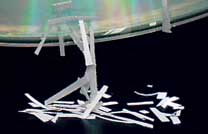Electrostatics is a branch of physics that deals with the phenomena and properties of stationary or slow-moving electric charges.
Since classical physics, it has been known that some materials such as amber attract lightweight particles after rubbing. The Greek word for amber, ήλεκτρον electron, was the source of the word 'electricity'. Electrostatic phenomena arise from the forces that electric charges exert on each other. Such forces are described by Coulomb's law. Even though electrostatically induced forces seem to be rather weak, the electrostatic force between e.g. an electron and a proton, that together make up a hydrogen atom, is about 36 orders of magnitude stronger than thegravitational force acting between them.
There are many examples of electrostatic phenomena, from those as simple as the attraction of the plastic wrap to your hand after you remove it from a package, and the attraction of paper to a charged scale, to the apparently spontaneous explosion of grain silos, the damage of electronic components during manufacturing, and the operation of photocopiers. Electrostatics involves the buildup of charge on the surface of objects due to contact with other surfaces. Although charge exchange happens whenever any two surfaces contact and separate, the effects of charge exchange are usually only noticed when at least one of the surfaces has a high resistance to electrical flow. This is because the charges that transfer to or from the highly resistive surface are more or less trapped there for a long enough time for their effects to be observed. These charges then remain on the object until they either bleed off to ground or are quickly neutralized by adischarge: e.g., the familiar phenomenon of a static 'shock' is caused by the neutralization of charge built up in the body from contact with insulated surfaces.

2. \
\
 \
\
paper strips attracted by charged CD.
Coulomb's law
We begin with the magnitude of the electrostatic force (in newtons) between two point charges  and
and  (in coulombs). It is convenient to label one of these charges,
(in coulombs). It is convenient to label one of these charges,  , as a test charge, and call
, as a test charge, and call  a source charge. As we develop the theory, more source charges will be added. If
a source charge. As we develop the theory, more source charges will be added. If  is the distance (in meters) between two charges, then the force is:
is the distance (in meters) between two charges, then the force is:
 and
and  (in coulombs). It is convenient to label one of these charges,
(in coulombs). It is convenient to label one of these charges,  , as a test charge, and call
, as a test charge, and call  a source charge. As we develop the theory, more source charges will be added. If
a source charge. As we develop the theory, more source charges will be added. If  is the distance (in meters) between two charges, then the force is:
is the distance (in meters) between two charges, then the force is:
where ε0 is the vacuum permittivity, or permittivity of free space:[1]
The use of ε0 instead of k0 in expressing Coulomb's Law is related to the fact that the force is inversely proportional to the surface area of a sphere with radius equal to the separation between the two charges.
These physical constants (ε0, k0, e) are currently defined so that ε0 and k0 are exactly defined, and e is a measured quantity.
now some more is on part 2




No comments:
Post a Comment